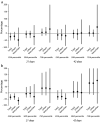A Spatiotemporal Tool to Project Hospital Critical Care Capacity and Mortality From COVID-19 in US Counties
- PMID: 33856876
- PMCID: PMC8101594
- DOI: 10.2105/AJPH.2021.306220
A Spatiotemporal Tool to Project Hospital Critical Care Capacity and Mortality From COVID-19 in US Counties
Abstract
Objectives. To create a tool to rapidly determine where pandemic demand for critical care overwhelms county-level surge capacity and to compare public health and medical responses.Methods. In March 2020, COVID-19 cases requiring critical care were estimated using an adaptive metapopulation SEIR (susceptible‒exposed‒infectious‒recovered) model for all 3142 US counties for future 21-day and 42-day periods from April 2, 2020, to May 13, 2020, in 4 reactive patterns of contact reduction-0%, 20%, 30%, and 40%-and 4 surge response scenarios-very low, low, medium, and high.Results. In areas with increased demand, surge response measures could avert 104 120 additional deaths-55% through high clearance of critical care beds and 45% through measures such as greater ventilator access. The percentages of lives saved from high levels of contact reduction were 1.9 to 4.2 times greater than high levels of hospital surge response. Differences in projected versus actual COVID-19 demands were reasonably small over time.Conclusions. Nonpharmaceutical public health interventions had greater impact in minimizing preventable deaths during the pandemic than did hospital critical care surge response. Ready-to-go spatiotemporal supply and demand data visualization and analytics tools should be advanced for future preparedness and all-hazards disaster response.
Figures



Similar articles
-
Estimated surge in hospital and intensive care admission because of the coronavirus disease 2019 pandemic in the Greater Toronto Area, Canada: a mathematical modelling study.CMAJ Open. 2020 Sep 22;8(3):E593-E604. doi: 10.9778/cmajo.20200093. Print 2020 Jul-Sep. CMAJ Open. 2020. PMID: 32963024 Free PMC article.
-
The J-IDEA Pandemic Planner: A Framework for Implementing Hospital Provision Interventions During the COVID-19 Pandemic.Med Care. 2021 May 1;59(5):371-378. doi: 10.1097/MLR.0000000000001502. Med Care. 2021. PMID: 33480661 Free PMC article.
-
Actions Taken by US Hospitals to Prepare for Increased Demand for Intensive Care During the First Wave of COVID-19: A National Survey.Chest. 2021 Aug;160(2):519-528. doi: 10.1016/j.chest.2021.03.005. Epub 2021 Mar 11. Chest. 2021. PMID: 33716038 Free PMC article.
-
Surge capacity principles: care of the critically ill and injured during pandemics and disasters: CHEST consensus statement.Chest. 2014 Oct;146(4 Suppl):e1S-e16S. doi: 10.1378/chest.14-0733. Chest. 2014. PMID: 25144334 Review.
-
COVID-19 Models for Hospital Surge Capacity Planning: A Systematic Review.Disaster Med Public Health Prep. 2022 Feb;16(1):390-397. doi: 10.1017/dmp.2020.332. Epub 2020 Sep 10. Disaster Med Public Health Prep. 2022. PMID: 32907668 Free PMC article.
Cited by
-
Predicting COVID-19 incidence in French hospitals using human contact network analytics.Int J Infect Dis. 2021 Oct;111:100-107. doi: 10.1016/j.ijid.2021.08.029. Epub 2021 Aug 14. Int J Infect Dis. 2021. PMID: 34403783 Free PMC article.
-
SPARSEMODr: Rapidly simulate spatially explicit and stochastic models of COVID-19 and other infectious diseases.Biol Methods Protoc. 2022 Sep 1;7(1):bpac022. doi: 10.1093/biomethods/bpac022. eCollection 2022. Biol Methods Protoc. 2022. PMID: 36157711 Free PMC article.
-
Prospective policy analysis-a critical interpretive synthesis review.Health Policy Plan. 2024 Apr 10;39(4):429-441. doi: 10.1093/heapol/czae009. Health Policy Plan. 2024. PMID: 38412286 Free PMC article. Review.
References
-
- Kluge H. WHO announces COVID-19 outbreak a pandemic. December 3, 2020. http://www.euro.who.int/en/health-topics/health-emergencies/coronavirus-.... Accessed March 29, 2020.
-
- Soucheray SUS. COVID-19 cases surge past 82,000, highest total in world. Available at: https://www.cidrap.umn.edu/news-perspective/2020/03/us-covid-19-cases-su.... Accessed March 29, 2020.
MeSH terms
LinkOut - more resources
Full Text Sources
Other Literature Sources
Medical
Miscellaneous

